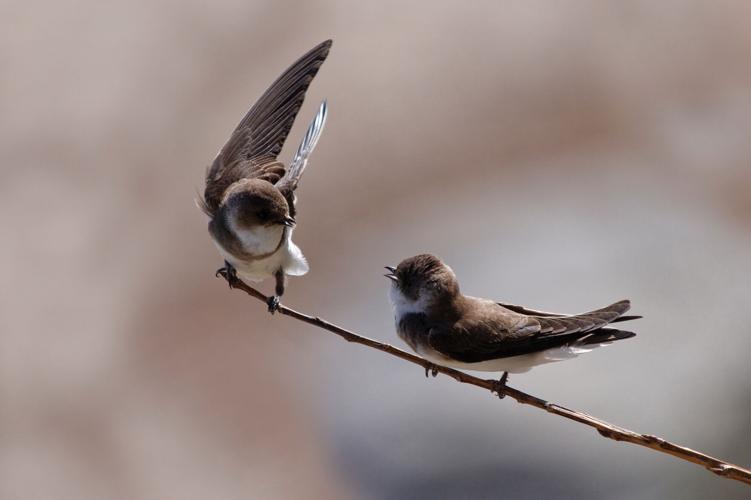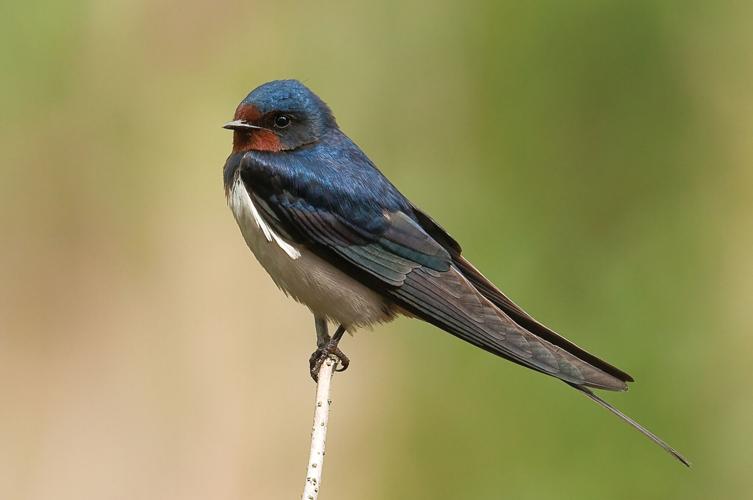All wild birds in North America are blessed with the gift of flight. Flightless emus, penguins, ostriches, and cassowaries live in far-off lands.
Among those that take most advantage of this gift are swallows. Rewarded by evolution with streamlined and graceful bodies, they spend most daylight hours in the air. Visit any open meadow or marsh and observe them dashing about, twisting and turning to capture flying insects. Five of the six swallow species are sparrow-sized birds with long wings that give them a larger appearance in flight. Those wings are sharply pointed at their ends, a feature that give swallows both grace and maneuverability.
Because they are so common, swallows are usually quickly added to birders’ lists of identifiable species. Thankfully, identifying them is straightforward, as follows:
1) Barn swallow

The barn swallow is not only the most common locally, but also the easiest to identify by its deeply forked tail. Those two feather “tines” stick out an inch or more from the rest of the tail. None of the other swallows have this feature; their tails are either squared or notched.
I once heard barn swallow’s coloration described as “blue on their backs with a reddish throat.” That description would fit a bluebird as well as a barn swallow, species that bear little resemblance. It shows how differently various colors can be represented. The blue on the barn swallow’s back is so dark, it appears almost black and its so-called red throat is really deep chestnut, both quite unlike the bluebird’s.
As their name suggests, barn swallows are often seen around farm buildings where they build nests. Human habitation does not deter them and you may find them gluing their nest mud in the garage over your car or even in your doorway. I recommend taking these nests down early to avoid a bigger cleaning job later; it doesn’t harm the birds as they can easily relocate.
2) Tree swallow

The tree swallow shares with the barn swallow a dark blue back, but what distinguishes it from other local swallows is its pure white throat and belly.
Tree swallows readily take to human-constructed bird houses and compete with bluebirds for them. That is why you often see two nest boxes erected within a few feet of each other. Tree swallows will occupy only one of those houses as they will not tolerate another nearby nesting swallow. They readily accept a noncompeting bluebird neighbor, however, so both species are well served.
3) Purple Martin

That same dark metallic blue covers the entire body of the male Purple Martin, giving it the appearance of an all-black swallow. It is also fifty percent larger than the other swallows. Females are not nearly so dark and have grayish breasts.
What is really distinctive about martins, however, is their preference for communal life in large manmade multi-apartment nesting structures that are usually erected near open water. Because these lovely birds are popular, there is real competition, once such a structure is set out, to attract them. Many birders play tapes of the martins’ twittering calls to attract newcomers during spring migration.
4) Cliff swallow

Cliff swallows are similar to barn swallows, but with a square tail. Cliff swallows are also communal, but their communities don’t reside in human-erected habitations. They build mud homes shaped like hornets’ nests, but with the opening on the side instead of the bottom; most nest under bridges and, occasionally, under overhanging features of farm buildings. I have occasionally enjoyed watching these handsome birds when they are nest-building. A number of them gather at a puddle, where they scoop up mouthfuls of mud and fly off to plaster it to their nests, without getting any soil on their plumage.
This is the swallow species known for returning to San Juan Capistrano in California on the same day each year.
5) Northern rough-winged swallow

The rough-winged swallow is the commoner of the two brown-backed swallows. It has a dusty brown throat. Unlike most other swallows, this is a solitary species most often found along streams or near lakes. They nest in crevices, pipes, and occasionally birdhouses. I look for them in areas where I would also expect to find phoebes.
6) Bank swallow

The other brown-backed swallow is the bank swallow. It differs from the rough-wing in its throat marking. On the bank swallow, the brown of its throat looks like a strap across its body between throat and chest.
I saw bank swallows more often when I was young and sometimes miss them for entire years of birding now, this despite the fact that many of them nest communally in vertical sand banks. Perhaps I saw them more often then because we had such a cliff near our home in Rochester. We climbed that cliff using the swallows’ nest holes for hand- and footholds.



















(0) comments
Welcome to the discussion.
Log In
Keep it Clean. Please avoid obscene, vulgar, lewd, racist or sexually-oriented language.
PLEASE TURN OFF YOUR CAPS LOCK.
Don't Threaten. Threats of harming another person will not be tolerated.
Be Truthful. Don't knowingly lie about anyone or anything.
Be Nice. No racism, sexism or any sort of -ism that is degrading to another person.
Be Proactive. Use the 'Report' link on each comment to let us know of abusive posts.
Share with Us. We'd love to hear eyewitness accounts, the history behind an article.